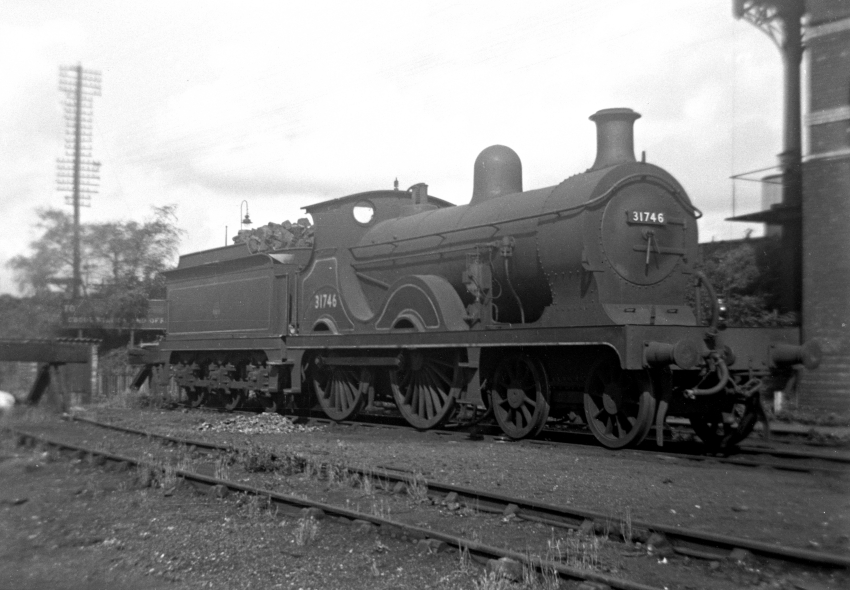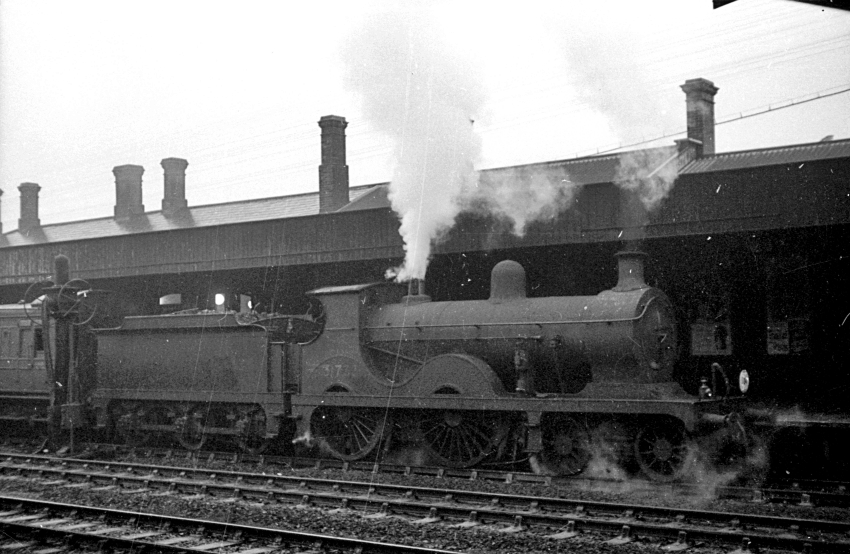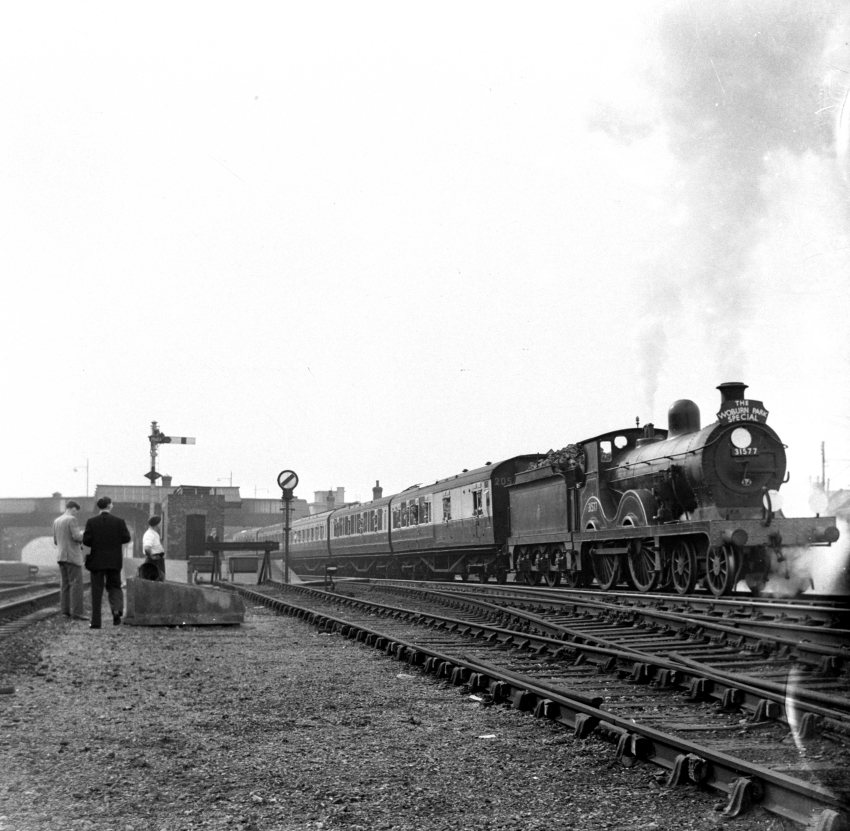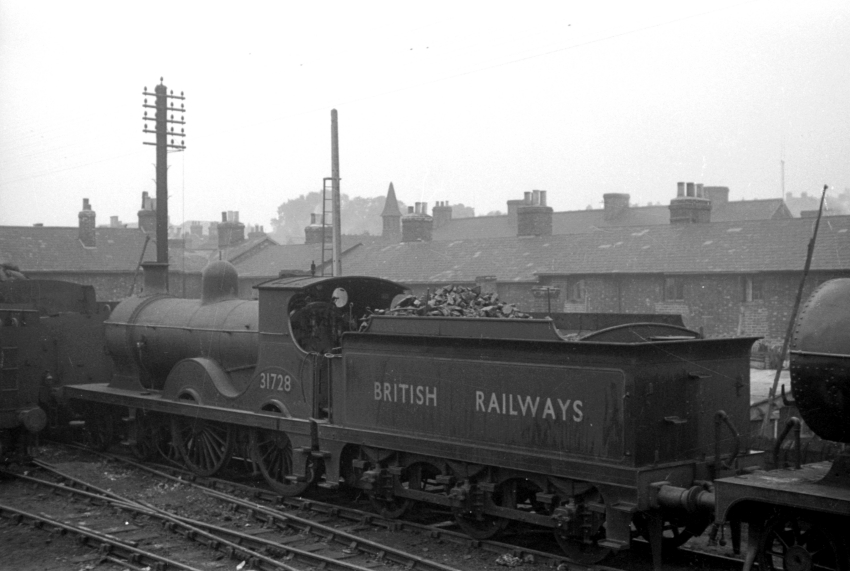Wainwright "D" Class
As of 1st January 1899, the operations of South Eastern and London Chatham & Dover Railways were brought under the control of a single Managing Committee. Known collectively thereafter as the South Eastern & Chatham Railway (SE&CR), Mr Harry S. Wainwright became Locomotive Engineer and Carriage and Wagon Superintendent of the joint operation. His promotion to this position from his existing title of Carriage and Wagon Superintendent of the SER was announced in the December 1898 edition of The Railway Magazine.
In October 1900, a large investment in rolling stock was announced by the SE&CR, to replace what were described as carriages with "dingy compartments" and Third Class stock with "unlovable hard seats" (ref: Daily Express (London), 12th October 1900). 1,500 vehicles of all kinds were on order, which would make up entire new train formations with a range of advancements over previous stock: electric lightning on a double battery system — driven off dynamos on the axles — instead of oil and gas lamps; more lavatories on main line stock; spring cushion seats in Third Class; and coach bodies mounted on Fox’s patent bogie frames (ref: Daily Express (London), 12th October 1900).
As part of this same wave of investment in railway vehicles, twenty new express locomotives were built under the direction of Wainwright. These locomotives were said at the time to be constructed for speed and gradient-climbing and, compared to existing engines, had a boiler 50% larger in size. The tender was reported as having a capacity of 3,300 gallons of water and the tractive effort of each engine was at that time given as 16,894lbs (ref: Daily Express (London), 12th October 1900). The first example of Wainwright’s then new express locomotive was envisaged to be ready in about March 1901 and it was planned to put it on display at the Glasgow Exhibition (ref: Daily Express (London), 12th October 1900). In the March 1901 edition of The Railway Magazine it was stated that Wainwright hoped to have delivery of some of his express engines in May.
Wainwright introduced a lettering system to classify the different types of locomotives on the SE&CR:
- Class B: Bogie Express Engine
- Class C: New Goods Engine
- Class D: New Bogie Express Engine
- Class O: Goods Engine
- Class Q: Bogie Tank Engine
- Class R1: New Bogie Tank Engine
- Class M3: Bogie Express
- Class R: Shunting Engine
(Ref: The Railway Magazine, March 1901)
Class "D" was a handsome inside-cylinder 4-4-0 express tender engine. Fifty-one of these locomotives were constructed between 1901 and 1908: twenty-one were built by the SE&CR at Ashford, the rest by contractors.
| Locomotive Numbers | Year Completed | Builder |
| 726 to 735 | 1901 | Messrs. Sharp, Stewart & Co. |
| 741 to 745 | 1901 | Messrs. Robert Stephenson and Co. |
| 736 to 740 | 1901 | Ashford Works |
| 57, 246, 487, 488, and 490 | 1902 | Ashford Works |
| 75, 92, 145, 247, 489, 492, 493, 494, 501, and 502 | 1903 | Messrs Dübs & Co |
| 746 to 750 | 1903 | Vulcan Foundry Co. |
| 470, 509, 545,549, and 577 | 1906 | Ashford Works |
| 477, 496, 505, 574, 586, and 591 | 1907 | Ashford Works |
(Ref: The Locomotive Railway Carriage and Wagon Review, 14th January 1922)
Period publications also refer to the engines as the "726" class, after the first of the series. No. 735 was displayed at the Glasgow Exhibition in 1901 (ref: The Locomotive Railway Carriage and Wagon Review, 14th January 1922). The locomotives were originally intended to run on the "Chatham" routes to Margate and Dover which, at 89-tons 3wt in working order (locomotive plus tender), they were near the maximum weight limit for. A feature inaugurated by Wainwright on "D" Class engines was that of copper-capped chimneys, although bright features such as this and brass domes started being painted over in 1913 (ref: The Railway Magazine, October 1928). In 1907, No. 247 was fitted with an extended smokebox as an experiment prior to the introduction of the large extended smokeboxes in the last batch of Wainwright’s "E" Class (ref: The Locomotive Railway Carriage and Wagon Review, 14th January 1922).
In the December 1913 edition of The Railway Magazine, it was reported that R. E. L. Maunsell had been appointed by the SE&CR as successor to Wainwright as Chief Mechanical Engineer. Until that time, Maunsell had been the Locomotive Carriage and Wagon Superintendent of the Great Southern and Western Railway of Ireland. In 1921, under Maunsell's direction, a rebuild of "D" Class locomotives began, the work being subcontracted to Messrs. Beyer, Peacock & Co (ref: The Locomotive Railway Carriage and Wagon Review, 14th January 1922). The modifications included a new cab design, a superheater, a larger Belpaire firebox, increased boiler pressure, a raised boiler centre line to accommodate new 10-inch piston valves above the cylinders (replacing previous side valves), an increased heating surface, and an enlarged grate area. The rebuilds became know as Class "D1", and the first batch of engines so treated were: Nos. 246, 247, 487, 489, 494, 502, 545, 735, 747, and 749 (ref: RCTS’ The Railway Observer, March 1930). Nos. 145 and 727 were converted to "D1" Class at Ashford in 1923 (ref: RCTS’ The Railway Observer, March 1930), after which rebuilding of "D" Class engines temporarily ceased.
1st September 1951

A grubby No. 31746, wearing BR lined black livery with early "Cycling Lion" crest, is seen at Reading. In the June 1951 edition of "The Railway Magazine", it was noted that No. 31746 had then recently arrived at Reading to join an existing allocation of Wainwright 4-4-0s — in the previous year, the engine had been shedded at Bricklayers Arms (73B) (ref: Ian Allan ABC Locoshed Book, 1950). The Reading-based Wainwright 4-4-0s were at that time deployed on passenger workings between there and Redhill. The brass dome had been painted over and the copper cap of the chimney gone, but these features aside, No. 31746 was still very much a Wainwright engine. She was one of a batch of five "D" Class locomotives, originally SE&CR Nos. 746 to 750, built by the Vulcan Foundry in Newton-le-Willows, Lancashire. No. 31746 remained in service until the end of 1954, being withdrawn from Guildford in December of that year (ref: RCTS’ The Railway Observer, March 1955). © David Glasspool Collection
Further rebuilds of the "D" Class recommenced in 1926: Nos. A470 and A505 were rebuilt at Ashford in that year into "D1" engines and were fitted with Ross "Pop" safety valves — several other "D" Class engines were reported as being in the course of rebuilding at that time (ref: The Railway Magazine, April 1927). Others so converted over the course of 1926 and 1927 included No. A741, also fitted with Ross "Pop" safety valves (ref: The Railway Magazine, May 1927); No. A492 (ref: The Railway Magazine, June 1927); Nos. A736 and A739 (ref: The Railway Magazine, July 1927); and finally, Nos. A509, A745, and A743, reported in the October 1927 edition of The Railway Magazine as then recently rebuilt from "D" to "D1" Class. That brought the number of "D1" engines rebuilt from "D" locomotives to twenty-one, and no further conversions were made. The "A" prefix of the numbers given here formed part of a system introduced by the Southern Railway (SR) to indicate the corresponding locomotive origin: "A" for Ashford, "B" for Brighton, and "E" for Eastleigh (ref: The Railway Magazine, February 1925). The system helped to distinguish between the locomotives that belonged to the erstwhile pre-Grouping constituents of the SR and avoided duplicate numbers. These prefixes were replaced from 1931 onwards: Ashford-built engines had 1,000 added to their existing pre-Grouping numbers (e.g. A726 became 1726); Brighton engines’ numbers had 2,000 added; former LSWR engines simply dropped the "E" prefix and kept their existing numbers; and locomotives on the Isle of Wight continued to use a "W" prefix (ref: The Railway Magazine, August 1931).
In the October 1926 edition of The Railway Magazine, it was reported that the bulk of Kent Coast traffic from Victoria was worked by Maunsell rebuilt 4-4-0s, Wainwright 4-4-0s, and Drummond small-boilered 4-4-0s of the "300E" class (also known as "T9" Greyhound).
The January/February 1945 edition of The Railway Magazine reported that "D" No. 1742 and "D1" No. 1747 had been scrapped, the first members of each class to go. The first "D" Class to be built, No. 1726 of 1901, was withdrawn in November 1947 from Ashford (ref: RCTS’ The Railway Observer, March 1948). At this time, Wainwright 4-4-0 engines from the SR’s Eastern Section were frequent visitors to Brighton on certain through trains from Tonbridge (ref: The Railway Magazine, November/December 1947).
On Nationalisation in 1948, twenty-eight "D" Class engines remained in service. In that year, a then new numbering system was introduced by British Railways (BR) to avoid confusion between the identities of locomotives of the former railway companies: the Southern Region was allocated the numbers 30000 to 39999 (ref: The Railway Magazine, May and June 1948). For the "D" Class fleet, that essentially meant adding a "3" prefix to their existing SR number.
By the 1950 edition of the Ian Allan ABC Combined Volume, current to 31st August of that year, No. 31738 had gone. However, the December 1950 edition of The Railway Magazine states that this locomotive was withdrawn from St Leonards (74E) on 16th September of that year. By that time, unrebuilt Wainwright 4-4-0s were not so prominent on the main lines, although could still be seen on hop-pickers’ trains and working from Tonbridge and Ashford (ref: The Railway Magazine, November 1950). Withdrawals in 1951 proceeded as follows:
- No. 31477 withdrawn from Ashford (74A) in January 1951 (ref: RCTS’ The Railway Observer, February 1951).
- No. 31730 withdrawn from Tonbridge (74D) in March 1951 (ref: RCTS’ The Railway Observer, April 1951).
- No. 31740 withdrawn from Reading (70E) in March 1951 (ref: RCTS’ The Railway Observer, April 1951).
- No. 31748 withdrawn from Faversham (73E) in March 1951 (ref: RCTS’ The Railway Observer, April 1951).
- No. 31057 withdrawn from Reading (70E) in March 1951 (ref: RCTS’ The Railway Observer, April 1951).
- No. 31731 withdrawn from Tonbridge (74D) in May 1951 (ref: RCTS’ The Railway Observer, June 1951).
- No. 31092 withdrawn from Tonbridge (74D) in June 1951 (ref: RCTS’ The Railway Observer, June 1951).
- No. 31490 withdrawn from Bricklayers Arms (73B) in August 1951 (ref: RCTS’ The Railway Observer, September 1951).
Locomotive Condemnation Programme
For 1953, the Southern Region announced a large-scale withdrawal of a series of pre-Grouping locomotive types. It was proposed to condemn the following engines:
- LC&DR Classes "R" and "R1" 0-4-4 Tanks.
- LB&SCR Class "D3" 0-4-4 Tanks.
- LB&SCR Class "E5" 0-6-2 Tanks.
- LSWR Class "D15" 4-4-0.
- Ten SE&CR Class "D" 4-4-0s.
- Ten SE&CR Class "C" 0-6-0s.
- Twelve LSWR "T9" 4-4-0s.
(Ref: RCTS’ The Railway Observer, March 1953)
In connection with the above programme, "D" Class withdrawals proceeded in that year as follows:
- No. 31750 withdrawn from Reading (70E) in February 1953 (ref: RCTS’ The Railway Observer, April 1953).
-
No. 31501 withdrawn from Gillingham (73D) in March 1953 (ref: RCTS’ The Railway Observer, April 1953).
- This locomotive subsequently became a static boiler at Ramsgate (74B) (ref: The Railway Magazine, November 2010).
- Nos. 31728 and 31744 withdrawn from Tonbridge (74D) and Reading (70E) respectively in April 1953 (ref: RCTS’ The Railway Observer, June 1953).
- No. 31733 withdrawn from Tonbridge (74D) in November 1953 (ref: RCTS’ The Railway Observer, January 1954).
Five engines having gone in 1953, another six were withdrawn between January 1954 and September 1955 inclusive:
- No. 31493 withdrawn from St Leonards (74E) in January 1954 (ref: RCTS’ The Railway Observer, March 1954).
- No. 31729 withdrawn from Tonbridge (74D) in April 1954 (ref:RCTS’ The Railway Observer, June 1954).
- No. 31746 withdrawn from Guildford (70C) in December 1954 (ref: RCTS’ The Railway Observer, March 1955).
- No. 31591 withdrawn from Guildford (70C) in May 1955 (ref: RCTS’ The Railway Observer, June 1955).
- No. 31496 withdrawn from Guildford (70C) in August 1955 (ref: RCTS’ The Railway Observer, September 1955).
- No. 31586 withdrawn from Guildford (70C) in September 1955 (ref: RCTS’ The Railway Observer, September 1955).
In October 1955, No. 31734 was withdrawn from Tonbridge (74D) (ref: RCTS’ The Railway Observer, November 1955). At the end of March of the following year, this engine was reported as being at Ashford shed sporting a smart external appearance in lined black livery, albeit out of use (ref: The Railway Magazine, May 1956). Rostered trips for the Tonbridge-allocated "D" Class had been an early train from Sevenoaks to Brighton; the non-stop run in each direction between Redhill and Brighton of a through Birkenhead service; assisting an 0-6-2 tank on the Lancing to Brighton evening workmen’s train; and, taking the 9:30 PM from Brighton to Tonbridge (ref: The Railway Magazine, November 1954).
No. 31488 was the next to go, being withdrawn in January 1956 from Guildford (RCTS’ The Railway Observer, March 1956). In the December 1956 edition of The Railway Magazine, it was reported that Nos. 31549 and 31574 had been spotted at Brighton Works in the September for scrapping; however, the November 1956 edition of the RCTS' The Railway Observer has October of that year as the date of withdrawal of both engines from Guildford. No. 31737, also of Guildford, went in November 1956 (ref: RCTS’ The Railway Observer, February 1957). Finally, the end of the "D" Class era on BR was marked by the withdrawal of Nos. 31075 and 31577 during the first fortnight of December 1956 (ref: The Railway Magazine, February 1957) — both had been allocated to Guildford (70C) (ref: RCTS’ The Railway Observer, January 1957).
After withdrawal in November 1956, No. 31737 stood in the yard at Ashford Works until being taken north to Tweedmouth in 1958 to be put into storage, prior to preservation (ref: The Railway Magazine, August 1958). In the following year, it returned to Ashford Works from store for cosmetic restoration and painting into SE&CR Brunswick Green (ref: The Railway Magazine, October 1959). From Ashford, the locomotive was towed to Nine Elms (70A) and, on 27th June 1960, was transferred to a Pickford’s low-loader and taken by road to a former London Transport bus garage in Clapham, which became the British Transport Commission’s museum (ref: The Railway Magazine, August 1960). This museum closed its doors for the last time on Easter Monday, 23rd April 1973 (RCTS’ The Railway Observer, June 1973), and No. 31737 moved north to York, where a then new museum was officially opened there on 27th September 1975 (ref: Survey of Current Affairs, H.M. Stationery Office, 1975).
13th October 1951

Very grubby, but still a graceful engine. The number is barely visible on No. 31733, as it is seen at Tonbridge on a Folkestone/Dover service from Victoria via Orpington, ex-SE&CR “Birdcage” stock in tow. As per No. 31728 pictured previously, No. 31733 was withdrawn from Tonbridge Shed, albeit later, in November 1953 (ref: Ref: RCTS’ The Railway Observer, January 1954). © David Glasspool Collection
Terminology
- Belpaire: Derived from Alfred Belpaire, a Belgian civil engineer based in Brussels who invented an improved steam engine firebox (ref: The London Gazette, 3rd January 1860).
- Firebox: The primary purpose of the firebox is to burn fuel (such as coal) to generate heat. This heat is then transferred to the boiler's water, producing steam that powers the locomotive.
- Grate: Located within the firebox of a steam locomotive, the grate is a metal framework of bars or mesh that supports the burning coal.
- Smokebox: The smokebox is located at the front of a steam locomotive. Its primary role is to collect and expel the hot gases and smoke produced in the firebox, after they have passed through the boiler tubes.
- Superheater: In a steam locomotive, a superheater is a device used to raise the temperature of steam beyond its boiling point without increasing its pressure, to increase efficiency and power.
- Tractive Effort: This is a measure of the pulling power of a locomotive.
- It represents the force exerted by the locomotive's driving wheels on the rails to move a train forward.
- This force determines how much weight a locomotive can pull and how well it can start from a stop or climb inclines.
- Cylinder Stroke: This refers to the distance that the piston travels within the steam locomotive’s cylinder during each complete movement from one end to the other.
- Cylinder Valve: This controls the flow of steam into and out of the cylinders, enabling the pistons to move and drive the locomotive's wheels.
- Safety Valve: This prevents the boiler pressure exceeding the safe limits of the design.
- The safety valve is configured to open at a predetermined pressure; when the pressure inside the boiler reaches this level, the safety valve opens to allow steam to escape.
- Top-Feed Boiler: The water used to generate steam is introduced into the boiler near its top.
- In doing so, the water has more time to absorb heat before reaching the main part of the boiler.
- This reduces the thermal shock of introducing cold water to the boiler; efficiency is also improved, because the water arrives to the main boiler area pre-heated.
23rd September 1956

"D" Class No. 31577 is seen facing north at Hendon with "The Woburn Park Special". This rail tour took visitors from Waterloo to Flitwick for Woburn Park and Abbey. The tour was scheduled to depart Waterloo at 9:32 AM, with passenger pick-ups at Clapham Junction, Putney, South Acton, and Hendon. It was due to reach Harlington at 11:41 AM and Flitwick at 11:50 AM (ref: The Railway Magazine, September 1956). The return fare from Waterloo was 8 shillings 6 pence, which at 2023 prices is about £13.40; the return fare from Hendon was 6 shillings 6 pence. Completed in 1906 at Ashford for the Kent Coast lines, by this time No. 31577 had been demoted to local passenger trains around Guildford and was withdrawn from service little over two months after this picture was taken. The 1950 edition of the Ian Allan ABC Loco Shed book, current to 31st August of that year, had No. 31577 down as an Ashford (74A) engine. © David Glasspool Collection
| Class | D | D1 |
| — | ||
| Cylinder Diameter | 19-Inches | 19-Inches |
| Cylinder Stroke | 26-Inches | 26-Inches |
| Cylinder Valves | Side | Piston |
| — | ||
| Driving Wheels Diameter | 6-Foot 8-Inches | 6-Foot 8-Inches |
| — | ||
| Heating Surface Tubes: | ||
| Small | 1,265 Square Feet | 827.6 Square Feet |
| Large | 322.25 Square Feet | |
| — | ||
| Firebox Size | 124 Square Feet | 127.13 Square Feet |
| — | ||
| Superheater | 228.0 Square Feet | |
| Grate Area | 20.3 Square Foot | 24.0 Square Foot |
| Working Pressure | 175 lbs | 180 lbs |
| Tractive Effort at 80% of Working Pressure | 7.33 Tons | 7.75 Tons |
| Engine Total Weight in Working Order | 50 Tons | 51 Tons 5 cwt |
| Tender Total Weight in Working Order | 39 Tons 2 cwt | 39 Tons |
(Ref: The Locomotive Railway Carriage and Wagon Review, 14th January 1922)
Return to the Kent Rail Homepage or alternatively, check for Updates.
Website & Copyright information - Links - Contact the Webmaster

